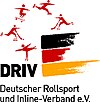German roller sport and inline association
| German roller sport and inline association | |
|---|---|

|
|
| Founded | March 7, 1998 |
| Place of foundation | Nuremberg |
| president | Egbert Schulze |
| societies | 589 |
| Members | 37,865 |
| Association headquarters | Frankfurt am Main |
| Homepage | driv.de |
The German Roller Sport and Inline Association e. V. ( DRIV ) is the umbrella organization for all German roller and inline skating athletes . The head office and legal seat of the association is Frankfurt am Main . Until 1998 the association operated as the Deutscher Rollsport-Bund . DRIV is a member of DOSB ( German Olympic Sports Confederation ), CERS (Confédération Européenne de Roller Skating) and World Skate .
sports
The association is divided vertically into state associations and horizontally into sports commissions (specialist divisions):
- Figure skating
- Roller hockey
- Inline fitness and speed skating
- Inline alpine and downhill
- Inline skater hockey , see Inline Skaterhockey Germany
- Inline hockey , see IHD game operation
- Roller derby
- skateboard
Inline Alpin is organized in cooperation with the German Ski Association.
Members
Members of the DRIV are the roller sports associations of the individual federal states (regional associations). Sports clubs are usually members of the respective national association. In 2019 DRIV had around 38,000 members. Increased membership numbers in the 2000s were primarily attributed to an inline boom by the DRIV.
The following regional associations are affiliated with the DRIV:
- Bavarian Roller Sports and Inline Association V. (BRIV)
- Brandenburg Roller Sports and Inline Association V. (BBRIV)
- Bremen Ice and Roller Sports Association V.
- Hamburger Eis- und Rollersport-Verband e. V. (HERV)
- Hessischer Rollsport und Inline Verband e. V. (HRIV)
- Inline and Roller Sports Association Berlin e. V. (IRVB)
- Landesfachverband Rollersport-Inline-Skater Mecklenburg-Vorpommern e. V. (MEVO)
- Landesverband Rollersport Sachsen-Anhalt e. V. (LVSA)
- Lower Saxony Rolling Sports and Inline Association V. (NRIV)
- Rhineland-Palatinate Ice and Roller Sports Association V. (RPERV)
- Roller Sports and Inline Association North Rhine-Westphalia e. V. (RIVN)
- Roller Sports and Inline Association Saxony V. (RIVS)
- Roller Sports and Inline Association Schleswig-Holstein e. V. (RIVSH)
- Saarländischer Eis- u. Rollsport Association e. V. (SERV)
- Thuringian Ice and Roller Sports Association e. V. (TERV)
In deviation from the state borders, Baden-Württemberg is divided into three state associations:
- Badischer Roll- und Inline-Sport-Verband e. V. (BRISV)
- Südbadischer Rollsport-Verband e. V. (SRIV)
- Württembergischer Rollsport- und Inline Verband e. V. (WRIV)
history
In 1910 the Federation of German Roller Skating Associations was founded and in 1924 it became a founding member of the Fédération Internationale de Roller Skating (FIRS). With the reorganization of sport in the 3rd Reich, the forced dissolution and the re-establishment of the German Rolling Sports Federation (DRB) took place in 1949. The federal government initially had three branches of figure skating, roller hockey and speed skating and was based in Frankfurt am Main. The sports commission skater hockey / roller hockey (later to: inline skater hockey) came to the DRB in 1990. Only high-speed roller skates were operated on inline skates from 1992 (optional until 1996), otherwise the DRB stayed true to the two-lane roller skates.
Expansion to inline skates
For a long time the DRB did not feel responsible for inline skating, so that on November 7, 1996 the German Inline Skate Association (DIV) was founded as an independent association in Frankfurt. In response, the DRB changed its name to DRIV (German Roller Sport and Inline Association) on March 7, 1998 and then declared itself responsible for inline skating. The DIV had too few members and could not join the German Sports Association, the DIV also wanted to avoid association disputes with the DRIV, so that the members of the DIV agreed to join the DRIV with a narrow majority.
Other sports that are now being supervised by the Skateboard and Inline Aggressive Sports Commission , which has since been renamed , are inline aggressive (stunt skating), inline skate basketball, inline skate cross, inline skate slalom, and inline skate high jump , Inline skate limbo, inline skate long jump and inline skate downhill.
According to a DOSB publication on January 1, 2008, the number of members was then distributed among the individual branches as follows:
- Figure Skating (7864)
- Roller hockey (2491)
- Speed skating (8185)
- Skateboard, inline and alpine (1703)
- Inline Skater Hockey (7542)
- Inline Hockey (2737)
In 2016, the IOC decided to host skateboard competitions as an Olympic discipline for the first time at the 2020 Summer Games . The DRIV has therefore been assigned to the top Olympic sports associations within the DOSB since 2018.
Web links
Individual evidence
- ↑ a b Inventory survey 2019 (PDF; 545 kB) German Olympic Sports Confederation, accessed on November 8, 2019 .
- ↑ DRIV: Chronicle. Retrieved May 27, 2015 .
- ↑ https://www.fachverbaende.de/fachverbaende/365/div-deutscher-inline-skate-verband-ev , accessed on October 31, 2018
- ↑ Arnd Krüger, Axel Dreyer: Sportmanagement: A Topical Introduction, p. 443
- ^ IOC approves five new Olympic sports . spiegel.de. Retrieved September 6, 2016.
